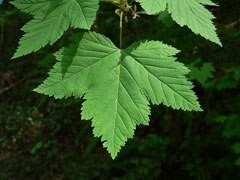Franchet’s maple
(Acer acuminatum)

Description
Acer sterculiaceum (Franchet’s maple, Himalayan maple) is a species of maple tree in the soapberry family. It is indigenous to Bhutan, northern India, and southwestern and central China (Guizhou, Henan, Hubei, Hunan, Shaanxi, Sichuan, Tibet, Yunnan). Acer sterculiaceum grows at altitudes of 1,800–3,100 metres (5,900–10,200 ft). It is a tree up to 20 meters tall with dark gray or grayish-brown bark. Leaves are palmately lobed, usually with 3 or 5 lobes but occasionally 7. Leaves are up to 20 cm long, thick and a bit leathery, dark green and hairless on the top, lighter green and woolly on the underside. Acer is a genus of trees and shrubs commonly known as maples. The genus is placed in the family Sapindaceae. There are approximately 132 species, most of which are native to Asia, with a number also appearing in Europe, northern Africa, and North America. Only one species, Acer laurinum, extends to the Southern Hemisphere. The type species of the genus is the sycamore maple, Acer pseudoplatanus, the most common maple species in Europe. The maples usually have easily recognizable palmate leaves (Acer negundo is an exception) and distinctive winged fruits. The closest relatives of the maples are the horse chestnuts. Maple syrup is made from the sap of some maple species. Most maples are trees growing to a height of 10–45 m (33–148 ft). Others are shrubs less than 10 meters tall with a number of small trunks originating at ground level. Most species are deciduous, and many are renowned for their autumn leaf colour, but a few in southern Asia and the Mediterranean region are evergreen. Most are shade-tolerant when young and are often riparian, understory, or pioneer species rather than climax overstory trees. There are a few exceptions such as sugar maple. Many of the root systems are typically dense and fibrous, inhibiting the growth of other vegetation underneath them. A few species, notably Acer cappadocicum, frequently produce root sprouts, which can develop into clonal colonies. Maples are distinguished by opposite leaf arrangement. The leaves in most species are palmate veined and lobed, with 3 to 9 (rarely to 13) veins each leading to a lobe, one of which is central or apical.
Taxonomic tree:







